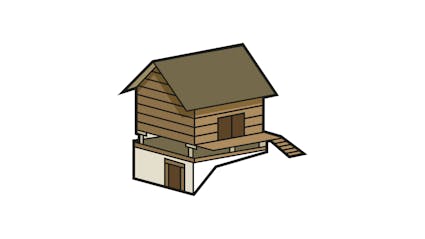832 – Granary
The granary comes from Campo in the Maggia valley, where a few of these typical Ticino granaries still exist.

Relic of Times Past
This building’s age is readily apparent: all that was smooth, white wood when the granary was built is now, centuries later, furrowed and burnt black by the sun. It is not only the general appearance that suggests great age; certain construction details also confirm the impression: the foundation sills which support the corner posts and thus the whole building are not sawn or dressed with the adze, but are logs left fully round. On the ends, the axe-cut notches for felling the trees are plainly visible.

Half a Millennium
Tree ring analysis confirms the impression: the wood for the granary, known in the local dialect as a “torba”, was felled in 1515. This granary comes from Campo in the Maggia valley, where a few of these typical Ticino granaries still exist. The body of the building, like that of Valaisan granaries, stands up on posts in order that air may circulate and dampness from the ground not reach the storage space of the granary. The stone plates on the posts are supposed to keep rodents from gaining access to the grain – on the other hand, some experts claim that they serve the purpose of statics in that they increase the bearing surface of the granary upon the slender posts.
Living in a Cellar?
An opening in the stone masonry provides access to a small room probably meant for some kind of storage. An opening in the cellar wall forms a niche, perhaps for containing a light. The smoke-blackened wall indicates a fi re place. What is the explanation? The granary stood an hour away from the village. Apparently it was sometimes used as a shelter, for cooking or even for staying overnight – like many of the buildings of the spring pastures on the alp.
Ballenberg
Swiss Open-Air Museum
Museumsstrasse 100
CH-3858 Hofstetten bei Brienz
Company holidays
24 December 2025 to 11 January 2026
Opening hours Administration
3 November 2025 to 8 April 2026
From Monday to Friday
8.30 am to 11.30 am
1.30 pm to 4.30 pm
Opening hours
9 April to 1 November 2026
10 am to 5 pm daily